Rewards and improvement in Dungeons & Dragons
Except for its first incarnation in Chainmail, Dungeons & Dragons has always had a very abstract character advancement system. Points were acquired for doing things “on screen”. They raised the character’s overall experience through succeeding “levels”. Each level brought with it greater abilities: combat for warriors (and, to a lesser extent, other characters), thieving for thieves, spells for mages, and increased ability to survive magic, poison, and other fantastic dangers, for everyone.
Chainmail
Chainmail, from 1971, is the only printed precursor to Dungeons & Dragons that I’m aware of. Chainmail was a set of rules for medieval wargaming. The main body of the rules dealt with military units, not with individuals. But the second-to-last chapter, Man-to-Man Combat, added rules for wargaming with individuals:
Instead of using one figure to represent numerous men, a single figure represents a single man.
When combined with the final chapter, the “fantasy supplement”, Man-to-Man set the stage for TSR’s later D&D. At the time, however, its “characters” were little more than military units of one.
Chainmail had no improvement. It did have characters of lesser and greater power. For warriors, there were heroes and super heroes: super heroes were “Hero-types in all cases, except they are twice as powerful.” For wizards, there were sorcerers, warlocks, magicians, and seers, each a less powerful version of the previous. But the rules provided no means for a seer to progress to a magician, or a hero to a super hero.
Dungeons & Dragons
The original Dungeons & Dragons books from 1973/1974 included a very simple experience point system. The inclusion of an experience system was one of the features that co-author Gary Gygax used to convince wargamers to try gaming, in a short article in Wargames Digest (May, 1974, as reprinted in Dungeon #112).
Players select a “character type” to begin the campaign—either a fighter, magic-user, or cleric…. Thereafter each “adventure” which the player survives adds to his “experience,” increasing his abilities proportionately.
Original D&D didn’t use level numbers. Each character type had a list of levels, with names resembling the names of Chainmail’s fantasy types. The Hero was the fourth level of fighting-man, and superhero the ninth level fighting-man. Seers, magicians, warlocks, and sorcerors were the second, sixth, eighth, and ninth levels of magic-users.
Characters advanced to a new level when they acquired the right number of experience points. On average it took 2,000 experience points to go from the first listed level to the second listed level, and the requirement doubled for each succeeding level.
Level advancement was used to limit the advantage of playing demi-human characters: Elves and Dwarves each had a maximum level above which they could not advance.
Characters gained experience points by killing monsters and taking their treasure. Monsters did have numerical levels, and characters received one hundred experience points for each level of monster they killed. Characters also received one experience point for each gold piece worth of treasure that they took from the monster(s). If the monster was less powerful than the character, the experience points gained from that encounter were reduced by a straight fraction: a fifth-level magic-user who killed a fourth-level monster and took 3,000 gold pieces of treasure from the monster’s lair gained 3,400 times 4/5, or 2,720 experience points.
Finally, if the character had a really good score in the ability that was most important for their character type, they gained a 5% or 10% bonus to their earned experience; if the character had a really poor score in that ability, they lost 5% or 10% from their earned experience.
A character’s experience point total was a measure of more than experience; it was also a form of “life force”. Certain undead, such as wights and wraiths, could “drain away life energy levels when they score a hit in melee”. In Chainmail, the same creatures merely paralyzed their opponents for a single turn (Wights) or “until touched by a friendly Elf, Hero-type, or Wizard” (Wraiths).
Life levels lost in this manner were gone for good in the original game. The only means of restoring them was the same way they were gained in the first place: kill more monsters and take more treasure. In early 1975 the first supplement to original D&D, Greyhawk, added a new spell for Clerics that would restore a single lost life level. But this was a difficult spell: it incapacitated the Cleric for 2 to 20 days, thus ensuring that “non-player Clerics cannot usually be hired to cast it.”
As a seventh-level spell, Restoration could only be cast by seventeenth-level Clerics, putting it out of reach of most characters during the period when they would need it most. My recollection of playing D&D and AD&D in the early eighties is that creatures which could drain life levels were feared the most of any encounter.
Greyhawk also changed the way that killing monsters contributed to a character’s experience. Instead of a simple 100 experience per monster hit die, which Greyhawk deemed “ludicrous”, Greyhawk provided a table of monster hit dice and experience gained for that monster. If the monster had special abilities, the experience points for that monster also increased, according to the monster’s level. If the monster had extra-special abilities, that particular bonus was doubled. Determination of special abilities was basically left up to the referee.
Greyhawk also added the phrase, “dividing experience equally among all characters in the party involved.” The italics is in the original. The original book didn’t describe what to do when multiple characters were involved with the kill or the treasure. The example and the rules described individuals. This led to a variety of interpretations. For example, my first gaming group used a “killing blow” interpretation: the character who got in the killing blow on a creature earned the full experience for killing the creature. Presumably, our game master—or the game master he’d first played under—did not use Greyhawk.
Greyhawk did not address how to divide experience from treasure among the party, and later editions of D&D interpreted this in different ways.
In late 1975 the second supplement to original D&D, Blackmoor, added some interesting twists to earning experience. Blackmoor added the assassin and monk sub-classes of character types. The assassin could gain experience by taking on paid assassination missions. The assassin gained the same experience as if the victim were a monster, plus 90% of their fee (measured in gold pieces), adjusted as normal for level disparity. I’m not sure if this implies that other character types did not get experience for killing non-monsters. It did add a means for assassins to gain experience for monies other than treasure.
Also interesting from Blackmoor is the way monks handled levels above the Grand Master (sixth) level.
Monks: The Order is structured in such a way that there is only one man at each level above the 6th (Grand Master). At such time as a 6th level character gains sufficient experience points to rank as 7th level he temporarily gains the appropriate attributes. He must then seek out the Grand Master of Dragons, and defeat him in a fair fight.…
The loser will be automatically dropped to exactly the number of experience points necessary to have attained the level immediately below that which is in question.… Members of the Order always know where to find the next higher member, although that person may be at great distance from the location of the challenger. The fight must take place as soon as possible (treat as a Geas).
Eldritch Wizardry, in 1976, extended the same concept to the druid sub-class. This meant that levels were a real thing within the game world. Player character and non-player character druids and monks knew whenever another druid or monk reached their level.
Monks and Druids also tied level advancement to social advancement. While the names of the levels (especially for clerics) were often political-class names, such as "Lord”, “Vicar”, or “Bishop”, until the rules for monks and druids there was no game requirement that the character act the part of their title.
Basic Dungeons & Dragons
There have been several versions of Basic D&D. Originally described as an intro to Advanced Dungeons & Dragons, it was later expanded into its own game.
The 1977 edition, the “blue book” that was described as an intro to Advanced D&D, clarified how treasure was divided up to become experience points:
Experience for treasure recovered is on the basis of 1 point for every gold piece. Convert jewelry, gems, etc. into gold piece value. Treasure is usually divided equally among members of the party and therefore experience is also. If, for some reason, one character gets more of the loot, such as a thief stealing gems from the saddle bags on the way home, then he should get the additional experience points.
Experience for monsters in the blue book appears to be the same table as from Greyhawk. They continued to be divided up equally among the party members.
The Dungeon Master usually takes all the experience earned by the party, treasure and monsters defeated, and divides it equally among all surviving members of the expedition.
The really interesting part here is not the moderately contradictory bit about treasure (it does say usually) but the new “clarification” that says that experience is divided equally among the surviving members. This meant that if a group of five adventurers headed into a dungeon, but four of them died in the final encounter, the remaining party member gained all of the experience. I did not play in any games where one player tried to ensure that the rest of the characters died just before leaving the dungeon, but there were stories.
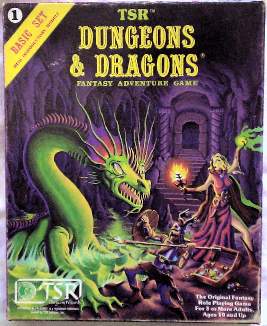
I have a soft spot for the 1981 edition, because it is the first D&D book I owned. It is important to remember that many of us did not use any one specific edition. Our game master used the blue book with pieces of the AD&D player’s handbook thrown in. I used what I remembered from his games, plus the 1981 D&D basic and expert sets, plus, later, the AD&D books. I only started using the AD&D books exclusively after going to college, and by then I was using several house rules.
In 1981, the basic set was revised again and given a red cover. This time, it was meant and described as its own game, with an “expert” set that followed. This edition was absolutely clear about treasure experience points:
DIVIDING XP: Treasure is divided by the party, but the DM handles all the XP awards. At the end of an adventure, the DM totals the XP from all treasures recovered plus all monsters defeated and then divides the total by the number of surviving characters (both player characters and NPCs) in the party.
An unequal distribution of treasure did not make for an unequal distribution of experience points.
In 1983 another revision of the basic set changed experience again, and again it was the interpretation of treasure experience. The Basic set split into two red books: a Player’s Manual and a Dungeon Master’s Rulebook. The experience calculations were in the DM’s book:
You should also remind them that they get 1 XP for each 1 gp of treasure. As treasure is divided by the party, without your interference, they must make such calculations themselves.
Player characters also began to be recognized as more important than non-player characters. Where the previous basic set noted that non-player characters might receive only half of the experience resulting from the even distribution, this set counts non-player characters as half of a participant even during the calculations. If a party of four player characters and four non-player characters go through a series of encounters that generate 1800 experience points, this will be divided by six. The player characters will then receive 300 experience each, and the non-player characters 150 experience points each.
Monsters appear to be getting more powerful, too. In the blue book the “experience points for monsters overcome” gave guidelines for up to 5 hit dice creatures. The 1981 red book went up to 6 hit dice. The 1983 red book went to 8 hit dice. Otherwise, the experience rewards were the same.
Fan improvements
The fan press was constantly proposing new rules for Dungeons & Dragons, and level advancement was one target.
In “Wizard Research Rules” in Dragon 5 (March 1977), Charles Preston Goforth Jr. appeared to suggest that major magical artifacts cost time, money, and experience points to create. Tom Holsinger appeared to suggest the same in The Judges Guild Journal 8 (February/March 1978).
In “D&D Options: Orgies, Inc.” in Dragon 10 (October 1977), Jon Pickens suggested awarding treasure experience when the treasure was spent rather than when acquired, so as to encourage players to get rid of it. In the same issue, Tom Holsinger pointed out that awarding experience “at the end of the adventure” was vague, and suggested requiring characters to perform religious rituals to gain new levels. Fasting, prayer, and ritual sacrifice could be performed to gain the attention of the appropriate deity.
D&D characters were originally focussed on their class abilities: fighting, thieving, or spellcasting. They had no other skills. In certain cases, such as weapon skill, they could do anything: if the rules said they could use the weapon, they knew how to use it.
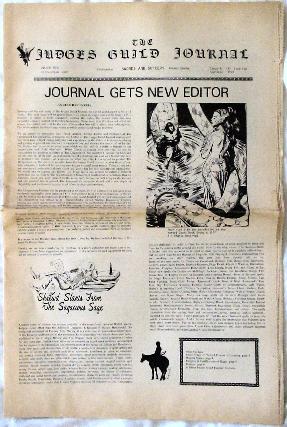
In the June/July 1978 issue of the Judges Guild Journal (issue 10), Tom Holsinger introduced a system where warriors and clerics did not start the game knowing the use of all weapons available to them.
Warriors and clerics should not enter the game automatically being skilled in every weapon allowed to their professions. Rather, the weapons which they may use should be limited initially and new ones should be allowed only as they rise in experience levels or go to the time, trouble and expense of learning them from a teacher.
He created a point system that gave characters a number of points to use for learning weapons. They gained new points for each new level. Learning the use of a weapon took both time and money in addition to the required skill points.
In the August/September 1978 issue of the Judges Guild Journal (issue 11), W. John Wheeler expanded upon that point system to add non-class skills such as swimming, natural philosophy, and lore. His system gave characters a set number of “skill points” at character creation with which they could acquire skills. Each skill took a specific number of weeks to learn. Acquisition of initial skills was turned into a game vaguely reminiscent of Traveller’s character creation: characters had a set number of skill points and 208 weeks, leading them from age 12 to age 16. They then gained skill points for every new level, and if they wanted to learn something they needed to take time out from adventuring to learn it.
As players we all appreciate the omniscient character. Though the DM might balk, we want to know everything and be able to do everything. It matters little to us that none of us in real life can do all of the things our adventuring characters can do. We don’t see anything wrong with playing fighters trained to use every weapon imaginable, or thieves so well-rounded that they are expert pickpockets even though they have never picked a pocket in their adventuring lives. Our characters are all expert woodsmen, gem appraisers, cartographers, and field medics—and they know about high magic from the first day that they set out on an adventure. After all, this is a fantasy game we play, and so these things are not unreasonable. Balderdash!
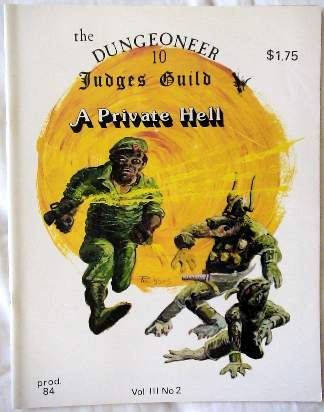
Over the course of several issues of Judges Guild’s The Dungeoneer, Bill Seligman created a complicated new system “with no character classes whatsoever”. Starting in the March/April 1979 issue (issue 10) he proposed to “eliminate the distinctions between such character classes as Thieves, Rangers, Assassins, Paladins, and their ilk.” As in the Journal’s proposals, learning skills took skill points, time, and money.
His skills also had “danger factors” which, if training were unsuccessful, would cause 1d10 points of damage for every week beyond the first that it took to train. “This damage is PERMANENT. No magic spell will restore it except Wish.” I don’t get the math in this article, but I hope that either failure or two-week training sessions were rare.
Besides altering the means by which experience was used, rules were offered altering how experience was gained. In the September/October 1979 issue of the Dungeoneer (issue 13), Mark Lewis proposed
a new type of experience based on hit points, not hit dice. D&D suggests that experience be given according to how powerful the creature killed is, gauging this through hit dice. I feel this may not be a good way to distribute experience. If you roll poorly for a creature that is normally powerful, that creature would be easier to kill than a creature which had excellent hit points. You would still get equal experience no matter which one you killed. THIS IS NOT RIGHT!!
The strong emphasis is my own; while there have always been people who would consciously modify the games they played, role-playing gamers have long considered the rules of their own games as “suggestions” rather then, well, rules.
Lewis’s system changed the means by which experience was apportioned as well: each character received experience for a creature based on the hit points of damage that character caused to the creature.
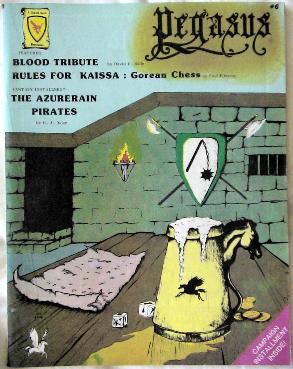
In the February/March 1982 issue of Judges Guild’s Pegasus, the “Blood Tribute” adventure by David Nalle and John Schuller introduced the “Schuller Progressive Experience System”. In this system, experience points were awarded per room or encounter, not per monster. The adventure’s designer provided an “experience value” for each encounter. When the adventure was completed, the experience values would be totaled up and compared to a chart to get the total experience points gained by the entire party. The total was then divided by the number of characters in the party.
This system was interesting because it also attempted to reward “role-playing”. Each character was ranked “on value and role-playing”. How well or poorly they ranked gave them an “XP Modifier” of from .6 to 1.5. Their own personal experience gain was multiplied by this modifier.
Advanced Dungeons & Dragons
Advanced D&D came out in pieces. First, the Monster Manual in December 1977, then the Players Handbook in June 1978 and finally the Dungeon Masters Guide in August of 1979. When I first saw the Dungeon Masters Guide… it was what Lovecraftian Mythos books would be if they were real. Individually, each section was interesting and complex. As a whole it was rambling, fascinating, and cryptic.
The Dungeon Masters Guide contained the new game’s experience rules. When Cecil Adams compared role-playing to double-entry bookkeeping, he was talking about AD&D’s experience point system.
The rule book is laden with such mystifying pronouncements as the following: “An ancient spell-using red dragon of huge size with 88 hits points has a BXPV of 1300, XP/HP total of 1408, SAXPB of 2800 (armor class plus special defense plus high intelligence plus saving throw bonus due to h.p./die), and an EAXPA of 2550 (major breath weapon plus spell use plus attack damage of 3-30/bite)--totalling 7758 h.p.”
He’s quoting from page 85 of the AD&D Dungeon Master’s Guide. He got some of the terms wrong, but who wouldn’t? I remember late nights with a calculator after each game determining how much experience the party received. These arcane calculations tended to reinforce the power of the Dungeon Master. Theoretically players did not have this information.
Your DM will award your character(s) experience points as explained. He or she has detailed information respecting this subject, and a chart of experience points to be given for monsters slain, with bonus points shown for special abilities of monsters.
The AD&D Players Handbook does describe what experience points are and when they are acquired:
Experience is the measure of a character’s ability in his or her chosen profession, the character’s class. Each player character begins the campaign at 1st level with no experience points accumulated. Thereafter, as he or she completes adventures and returns to an established base of operations, the Dungeon Master will award experience points to the character for treasure gained and opponents captured or slain and for solving or overcoming problems through professional means.
It also addressed concerns about the appropriateness of gaining experience through killing and plunder.
Gaining experience points through the acquisition of gold pieces and by slaying monsters might be questioned by some individuals as non-representative of how an actual character would become more able in his or her class. Admittedly, this is so, if the existence of spell casting clerics, druids, magic-users, and illusionists is (unrealistically) granted; likewise, dwarven superheroes, paladins, elven thieves, half-orc assassins, and the like might gain real experience from altogether different sorts of activities. This is a game, however, a fantasy game, and suspension of disbelief is required. If one can accept the existence of 12’ tall giants, why not the rewarding of experience points for treasure gained? While praying and religious-oriented acts are more properly the activities for which a cleric would gain experience points, this is not the stuff of exciting swords & sorcery adventure. So too, fighters need physical training and weapons practice, magic-users long hours of study in tomes of arcane lore, and thieves the repetition of their manual skills and discernitory prowess; but none of this is suitable to gaming. It is, therefore, discarded and subsumed as taking place on a character‘s “off hours”.
Characters gained experience through those activities because those were the activities that the game should encourage. The Dungeon Masters Guide added that awarding experience for more realistic activities would be “conducive to non-game boredom!” (DMG, p. 85)
Assassins continued to gain experience for assassinations, and in this case the experience was in addition to the assassin’s fee and the experienced gained from the killing (DMG, p. 20).
Magic items were given a specific experience point value, which was “only a relatively small amount of experience points, for their value is in their usage” (DMG, p. 85).
Division of experience from treasure remained in the players’ realm. The Dungeon Master was given control over the amount of experience gained per gold piece of value, but the experience so earned was divided according to who had the treasure. The Dungeon Master was given full control over the division of experience from killing or capturing monsters (DMG, p. 85):
How treasure is divided is actually in the realm of player decision. Experience points (x.p.) for slain monsters, however, is strictly your prerogative. It is suggested that you decide division of x.p. as follows:
It was then suggested that all “surviving characters who took part (no matter how insignificantly)” get an “equal share” of the total.
The amount of experience gained per gold piece of treasure was to be adjusted according to how difficult the acquisition was. This was “determined subjectively” (DMG, p. 84), based on the dangers of the traps guarding the treasure, the strength of the creatures guarding the treasure, and the relative difficulty of acquiring the treasure.
Training
With all the talk of how training was boring, Advanced Dungeons & Dragons added one very significant change to level advancement: level progression was no longer automatic. Once their experience point total indicated that they were eligible for a new level, characters needed to spend time and money training under a tutor to actually acquire the new level.
The Dungeon Master had to rate each character according to how well they performed “in the character of his or her class” and “in keeping with his or her professed alignment” (DMG, p. 86) during the previous level. Characters needed to spend one to four weeks training, depending on whether their performance was Excellent, Superior, Fair, or Poor. Each week of training would (a) remove the character from the game for that period, and (b) cost 1,500 gold pieces per level of the character per week. A first level character needing to achieve second level and rated Superior would need two weeks and 3,000 gold pieces.
Unless rated Excellent, a character would generally (at low levels) require more gold than experience to advance.
Characters eligible for a new level did not receive any more experience points until they had trained and acquired that new level.
One addition to Advanced D&D was weapon proficiencies. Instead of being able to use any weapon open to them, each character began the game proficient with a specific number of weapons, and gained new weapon proficiencies every three to six levels. Warriors gained them the fastest, and magic-users the slowest. This wasn’t a big change at the time, but it led into non-weapon proficiencies in later versions of the game.
Unearthed Arcana
In 1985, the first major change to AD&D was released: the Unearthed Arcana sourcebook. It made no changes to experience, but it did increase the level limits of demi-humans. In some cases, the actual level limits were increased. In all cases, a character that devoted itself to a single class when they didn’t have to had their limit increased by two. Author Gary Gygax addressed the reasons for both the limitations and their increase in “Demi-humans get a lift” (Dragon Magazine 95, March 1985):
After long contemplation of the plight of dead-ended demi-human characters, and considerable badgering from players with same, it seemed a good plan to work up some new maximum levels for those demi-humans with super-normal statistics—and in a couple of cases just reward those with high stats across the board. Demi-humans were limited in the first place because I conceived of a basically human-dominated world. Considering their other abilities, if most demi-humans were put on a par with humans in terms of levels they could attain, then there isn’t much question who would be saying “Sir!” to whom.
Massive experience point requirements were used to balance out the new and massively powerful Barbarian class. Previously, Paladins (a subclass of Fighters) had required the most experience to advance: 2,750 experience points to reach second level. The new Barbarian class required 6,000 experience points to reach second level.
Oriental Adventures
All the way back to original D&D, characters of high intelligence could be created knowing extra languages. In 1985, after Unearthed Arcana, Oriental Adventures extended the concept of “weapon proficiencies” to include “non-weapon proficiencies”. Characters gained new proficiencies more quickly as their levels advanced, and could use them either for weapon proficiencies or non-weapon proficiencies. Proficiencies were basically skills, such as blacksmithing, survival, or dancing.
Dragon Magazine
AD&D had its share of fan-created rules, most of them in TSR’s own Dragon Magazine.
In “Experience: By Doing and Learning” in Dragon 35 (March 1980), Lenard Lakofka suggests that rather than awarding experience for treasure taken, that experience should come when the treasure is paid to a trainer. He also suggests giving small experience awards for “acts directly related to a character’s profession”.
In “Experience Points to Ponder” in Dragon 36 (April 1980), William Fawcett suggests awarding experience points for hit points of damage caused, regardless of whether the opponent is killed, because “you can learn from failure, if you live to think about it.” He also added small experience point awards for casting spells in melee or hostile surroundings.
In “Credit Where Credit is Due” in Dragon 95 (March 1985), Katherine Kerr suggested replacing kill/treasure experience awards with goal-based experience awards. Recognizing that awarding experience for killing monsters and taking treasure discouraged adventures that did not involve killing and looting, Kerr suggested identifying the major goals of the adventure, and assigning experience awards for meeting them.
The training costs required for advancing in level came under fire in the November 1986 White Dwarf (issue 83). In “Counting the Cost”, Carl Sargent noted that not only would training costs for a new level exceed the gold needed to acquire it, the problem is at its worst for lower-level characters. If a DM rated a thief as average, that thief would need 2,500 experience points to reach third level, but 13,500 gold pieces to pay for training. Sargent goes on to ask:
Before trying to correct the problems, one central question needs considering; just what is a character learning anyway? Answering that gives us the building blocks for constructing a superior system for determining training costs.
Sargent then described a lengthy system for training that took into account what bonuses the character was to receive at the new level. One interesting recommendation (not part of his new rules):
My own players were required, when their PCs were needing training to gain second level, to fill in forms from official guilds which (amongst other things) required them to state in 100 words or less why they felt they were suitable candidates for training. Now that was fun, and I commend it to any GM!
In “A Hero’s Reward” in Dragon 118 (February 1987), Leonard Carpenter suggested adding Hero Points to the character rewards for level advancement. Hero Points could be used to modify die rolls on a one-to-one basis. At each level advancement, a character gained up to their new level in Hero Points, depending on how well they had role-played their class and alignment.
Second Edition AD&D
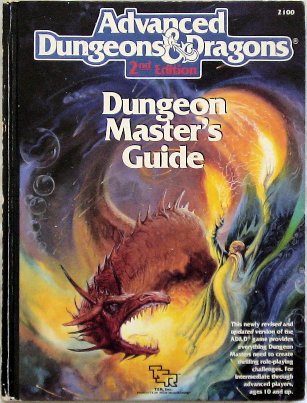
Second edition, in 1989, simplified the entire game, and experience calculations benefited. Further, the rules were more clearly explained. Much of the remaining heft of second edition AD&D was in the explanations of the remaining rules:
Since group cooperation is important, experience points for defeating foes are given to all members of the group, regardless of their actions. Who is to say that the wizard, standing ready with a spell just in case things got ugly, might not have been necessary? Or that the bard who covered the party’s escape route wasn’t doing something important? A character who never hefts a sword may still have good advice or important suggestions on better tactics. Furthermore, the wizard and the bard can also learn from the actions of others.
Second edition had two sources of experience: group experience and individual experience. Group experience was shared “among all members of the adventuring party, regardless of each individual’s contribution.” Once again, the experience is shared by the surviving members of the group.
Groups gained experience “for victory over their foes”, “which is not necessarily synonymous with killing”. Driving off foes, outsmarting them, or accepting surrender allowed characters to gain experience from the encounter.
The experience point value for a creature also reverted to a simpler system more similar to Basic D&D: a chart comparing hit dice to XP value, with modifiers to hit dice for special abilities. What constituted a special ability, and how much of a hit die bonus it shifted on the XP value chart, was more clearly defined, with a table of sample abilities and their Hit Die Modifier.
There was no longer a calculation required based on the relative difficulty of the encounter as in earlier versions of both AD&D and D&D. The characters either received full experience (if there was risk) or no experience (if there was no risk).
A 7th-level player character who needs one more experience point to advance in level can’t just gather his friends together and hunt down a single orc. That orc wouldn’t stand a chance, so the player character was never at any particular risk. If the same character had gone off on his own, thus risking ambush at the hands of a band of orcs, the DM could rule that the character had earned the experience.
There was also a “story award” rewarded for completion of the adventure. In general, the story award “should not be greater than the experience points that can be earned defeating the monsters encountered during the adventure.” Beyond that, the story award was left to the Dungeon Master, “based on the adventure’s difficulty”.
Individuals gained experience for doing things related to their class. Warriors received extra experience for the toughness of the creatures they defeated; priests for spells cast to further their ethos; wizards for spells cast to overcome problems; and rogues for each successful use of one of their special abilities. Such actions needed to be “significant”: the ability had to be a reasonable means of solving the problem it addressed, and “there must be significant danger”. Whether significant or not, characters gained no experience when “attemtping to use his abilities at the expense of others” in the party. “Player characters should cooperate in order to succeed.”
Experience for treasure became an optional rule. Demi-human level limits became optional: Dungeon Masters had the option of choosing instead to reduce the amount of experience earned by demi-humans, so that their advancement was unlimited but slower.
Training became an optional rule as well. Even if training were required, the recommended cost dropped to “an average of 100 gp per level per week” with the number of weeks no longer related to the DM’s estimation of the player’s level of play, but rather to the tutor’s wisdom, for an average of perhaps 5 to 7 weeks for tutors with slightly above average wisdom. Players also needed to make a d20 roll against the highest of their character’s Wisdom or Intelligence. This meant that costs were generally quite a bit lower than under the first edition rules.
Second edition also contained advice on how rapidly characters should advance.
An average pace in an AD&D game campaign is considered to be three to six adventures per level, with more time per level as the characters reach higher levels.
But by far the biggest change to character advancement in second edition was the replacement of languages with non-weapon proficiencies. Technically, the second edition Players Handbook speaks of proficiencies as if they were an optional rule to use instead of languages, but they have an entire chapter dedicated to them. Unlike Oriental Adventures, weapon proficiencies and non-weapon proficiencies were kept separate. Weapon proficiency acquisition remained the same in second edition.
Adventures in Fantasy
Both of the authors of the original D&D, Dave Arneson and Gary Gygax, went on to write their own fantasy games after Dungeons & Dragons. Arneson’s Adventures in Fantasy came out in 1978. In the April/May 1981 issue of Judges Guild’s Pegasus, Arneson was interviewed by editor Harold Kahn and his game was reviewed by Clayton Miner.
In the interview, Arneson summarized the differences between his game and the others on the market:
It’s easier to understand than Chivalry & Sorcery c; it follows a more traditional medieval setting than Runequest c; it uses spell point magic; it didn’t go into a lot of esoteric things in the basic volume that I thought were distracting. I felt that it would be a better system for getting into fantasy games because they would get more into role playing a lot of the other systems like Tunnels and Trolls c don’t get into the whole playing aspects of fantasy gaming and they don’t have an educational system. Runequest c has an educational system but is heavily involved in its own world.
I wanted to bring these elements together while at the same time being different. I asked myself how I would be different in my interpretations of how to deal with spell point magic and how I would bring that together with an educational system, role playing, and social status. There is probably no single element in Adventures in Fantasy c that can’t be found in some other system, but there is no other system that brings it all together. I worked out my own systems, for example Runequest c has its own educational system. There I go talking about education again but it’s very neglected in most systems.
I don’t have a copy of the game, but from the review it appears that it required characters to take time out to learn new things:
What probably started out as an interesting way to set up a character’s background has continued on to be yet another problem area which operates against the character. This is the section covering the education of the character, in which a player determines the ‘course’ taken in the past to prepare a character for play. These rules open interesting possibilities, but if a player enters into a course while an adventurer, they are effectively pulling their character out for several months.… If it was not for the system to set up courses taken before the character came into play, this system would be a wasted effort, as it takes too much of the character’s time.
Empire of the Petal Throne
M.A.R. Barker, the author of Empire of the Petal Throne, the first world-setting for gamers, moved away from D&D-based rules in favor of his own ruleset as well. In an interview in the October/November 1980 issue of The Dungeoneer Journal (issue 23), Barker told Rudy Kraft that experience was one of the reasons.
There is also the problem of experience which is very casually dealt with in the first EPT. The idea that you could be promoted in society by killing things and getting money is not very realistic.
Dangerous Journeys
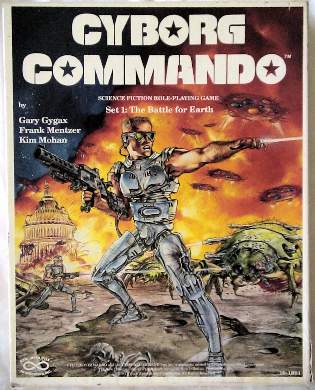
In later games, Gary Gygax (along with Frank Mentzer and Kim Mohan) moved away from abstract, level-based character advancement and towards point-based advancement of individual skills and capabilities. In Cyborg Commando (1987), characters gained SP (Stat, or Skill, Points). Players started with a specific number of SP to create their character, and later gained SP during play, which they could use to increase stats or skills, or to acquire equipment. If characters didn’t have the cash to acquire equipment, they could use SP to do so.
Since such a purchase essentially amounts to trading experience for material objects, you can imagine the procedure in the following way. The character goes to a supply officer or other CCF staff member at the base and asks what is in stock, or requests a specific item. In the course of the subsequent conversation, the CC tells the staffer a few stories about missions. The staffer decides that the CC has earned the privilege of getting and keeping the item, gives it to the character, and fills out the appropriate forms. No money changes hands, but the character has “spent” some of his or her reputation and experience (SP) in acquiring the equipment.
Gamemasters were expected to reward SP for role-playing properly, cooperating with the other players, acting heroically yet responsibly, avoiding unnecessary violence, achieving their goals, and suggesting ingenious solutions.
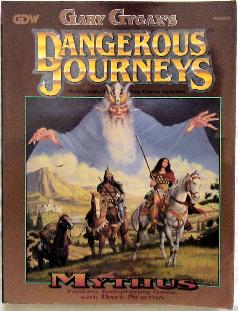
In Dangerous Journeys (1992), Gary Gygax (and Dave Newton) moved slightly away from point-based character creation. Attribute totals were created either randomly or chosen from a list of numbers. Skills were generated through choosing a profession. Advancement during game play, however, was point-based.
The gamemaster awarded three different kinds of accomplishment points. At the end of a scenario, the gamemaster awarded general points, which could be used to increase attributes or skills. General accomplishment points were awarded for participation in the game, for degree of success in meeting the goals of the scenario, and for the length or difficulty of the scenario.
During play, specific skill accomplishment points could be “awarded for succeeding in difficult rolls and/or making skillful and clever use of one’s” knowledge and skills. It was up to the gamemaster how much and whether such activities were rewarded with advancement, but if it was, the advancement occurred immediately.
The gamemaster could award “exceptional performance” accomplishment points. Exceptional accomplishment points could immediately raise an attribute, add to the character’s ability to affect die rolls (Joss Factor), or give the character a special connection (an individual that could be “especially helpful during the course of an adventure”).
Characters could also spend time and money to increase skills and attributes. The ability to affect die rolls increased at a marginal rate on an annual basis, regardless of what the character was doing.
In the gaming magazine Journeys 3 (December 1992), Gygax suggested that “Accomplishment Points, General should be given out at nearly every play session. The single player showing the greatest skill during the evening might be awarded an AP/G, with a comment on the reason why.” The same article suggested giving out Joss Factors for “good play”.
Third Edition Dungeons & Dragons
In the third edition, which dropped “Advanced” from the name (and dropped the “basic” line completely), Dungeon Masters cross-referenced the challenge rating of an encounter with the character’s level to determine experience point awards. Challenge ratings measured encounter difficulty in a more abstract manner, removing the intense calculations required in the previous editions—as long as the challenge rating has already been determined.
Challenge ratings measured the overall difficulty of the encounter: if, for example, a wizard summoned another creature, the characters did not receive an award specifically for defeating that creature. The wizard’s CR already took into account the possibility of a summoning. Likewise, characters did not receive any additional experience for the treasure acquired from the encounter.
Since experience points were determined per encounter, there was no “surviving character” loophole. Characters that died during an encounter explicitly received a share of the experience award for that encounter.
By removing the requirement that experience awards come from the hit dice and treasure of opponents, experience awards became more flexible. Challenge ratings could be assigned to non-combat encounters such as traps, for example. Dungeon Masters could adjust CRs according to circumstances.
DMs were also encouraged to give “mission awards” for achieving an adventure’s goal as well as defeating its traps and monsters. Mission awards “should be more than the XP for any single encounter on the mission, but not more than all standard awards for encounters for the mission put together.”
The DM could also provide awards for individual goals, and for role-playing that “enhances the game”.
Players continued to offer alternative uses for and methods of gaining experience points in D&D 3. Adam Dray, for example, proposed using experience points to purchase “character bonds”, bonds to people, places, things, emotions, “anything that can be connected to your character somehow.” If a character did something “significant related to that bond” they gained an experience award. If they failed to play their character’s bond, they lost experience points. The bond also meant that the bonded item was unlikely to be lost. The bond provided a pool die roll bonuses that the player could use for actions relating to that bond.
Money and Equipment
In all of these games, with the possible exception of Chainmail, another means of improvement was to buy it with money. Characters started with an initial allotment of money that let them purchase basic weapon and armor. As they brought back treasure from dungeons, or fees from jobs, they could purchase better weapons, better armor, and better equipment. They could purchase faster and more powerful horses, for example, and sailing ships. Treasure allowed them to kill better, to better avoid being killed, and to extend the distance they could travel. There were quite a few things that money could buy that increased character effectiveness.
In Chainmail, the characters, their abilities, and their equipment were static, in the sense that there were no rules for acquiring better armor or weapons. The possibility existed: the “man to man melee table” cross-referenced the attacker’s weapon to the defender’s armor, and different weapons were more or less likely to score a hit depending on the armor they attacked. But there was no list of equipment and costs, nor guidelines on setting them. Weapons generally did the same amount of damage regardless of weapon type: they scored a “kill”. In general, once hit, the defender died. Only heroes and superheroes could sustain multiple hits.
Original Dungeons & Dragons ostensibly retained the Chainmail system, but provided a list of weapons, armors, and costs in gold pieces. Original D&D did not provide the Chainmail attack system, recommending instead that gamers purchase that system. For those that did not have Chainmail, it provided a simpler alternative system of hitting; weapons in the alternative system did not kill outright, but did all cause the same number of “hit points” damage. Under this alternative system there wasn’t any advantage to having different kinds of weapons. All had the same chance to score hits and all resulted in the same number of hit points damage.
It was only in Supplement I, Greyhawk, that weapons gained differing abilities within the “alternative” combat system. Greyhawk provided two additional tables. One altered the success chance for different weapons against different armor classes, and the other altered the damage that each weapon did. A sword caused about twice as much damage as a dagger, for example.
Later versions of the game expanded the equipment list, providing for a wider variety of weapons. The various forms of Basic Dungeons and Dragons lost the weapons vs. armor class variation, but kept the damage variation.
Summary
At first, level advancement was all or none: there was no way to increase one capability without others. When a character gained a level, their capabilities all increased. AD&D introduced a very slight change to this: players could choose a weapon proficiency for their character every few levels. In second edition, the “optional” non-weapon proficiencies changed this again: a player could choose a non-weapon skill every once in a while also. Third edition added even more choices to character advancement, with feats as well as proficiencies.
Character improvement continued to focus on encounters with strange creatures throughout all versions of the game. If a player wanted their character to advance, they either needed to defeat monsters and take their stuff, or assist other characters in doing so. AD&D specifically explained that this is what the system was designed to encourage: adventures “suitable to gaming” rather than “non-game boredom”.
Within that framework, the game began tweaking the experience system right from the second supplement to original D&D. How should encounter experience be measured? How to measure the appropriate experience for encounters? How should the experience be shared, and under whose control? The experience system is central to the Dungeons & Dragons games, and the answers to those questions reverberates throughout play.
Experience and Advancement in Role-Playing Games
- Rewards and improvement in Dungeons & Dragons <-
- Experience in Generic Role-playing Games
- Experience in world-based role-playing games
- Experience in thematic role-playing games
- Facets of character improvement rules
- New, improved experience rules for Gods & Monsters
- Chainmail
- “The progenitor of Dungeons & Dragons. Ostensibly a straight-wargaming rulebook for miniatures, its ‘Fantasy Supplement’ sparked a phenomenon.”
- Dungeon Master’s Guide
- “After more than two years since tantalizing players with the AD&D Monster Manual, Gygax finished work on his most impressive project, the Dungeon Masters Guide. Oft-criticized for its complicated rules and wordiness, the DM’s Guide nevertheless has held up remarkably well over time, and is an impressive milestone in role-playing-game history.”
- Dungeons & Dragons Basic Set
- “The first half of the ‘D&D Dichotomy’, and successor to the Original D&D Set. Developed chiefly because of disagreements with Gary Gygax over the direction D&D should take; Gygax favored a far more structured and complicated system (AD&D). Basic D&D retained the simplicity and flexibility which made Original D&D a bestseller.
- Original D&D Supplements
- These supplemental rulebooks for Dungeons & Dragons added thieves, paladins, monks, assassins, and druids, as well as new creatures, spells, and magic items.
- Original Dungeons & Dragons
- “Yes, the ‘granddaddy of them all’. Published by Tactical Studies Rules, a fledgling company (at the time) of Gary Gygax, Don Kaye, and Brian Blume. The game is based on the fantasy portion of the earlier Chainmail rules, and contains three booklets: Men & Magic, Monsters & Treasure, and Underworld & Wilderness Adventures.”
- What’s the deal with Dungeons & Dragons?
- Cecil Adams tackles determining the experience point value of ancient dragons.
- Dungeon 112 (July 2004)
- Dungeon 112 is a special issue of Dungeon Magazine devoted to old-style TSR goodness!
- Character bonds
- “Players invest into Character Bonds to get bonuses to rolls and get more XP by acting towards those bonds. On the flip side, you can also get penalized XP for working against your Bond. Bonds work like Flags, as well as changing the way in which players get XP, so it's completely possible to have a non-combatant character gain XP and advance as much as the combatative type.”
More gaming history
- The Cult of the Cult of Gygax™
- It was never a secret to us back in the day that the staff at TSR played the game themselves, and that they played the game with custom rules and custom worlds.
- Was table-top gaming inevitable?
- Gods & Monsters rolls an 18 for age today, pioneer game writer Greg Stafford died two weeks ago, and stories about the early days of gaming has me wondering, was the discovery of table-top gaming a perfect storm, or was it inevitable?
- Gary Gygax’s game
- Links around the net to people talking about Gygax.
- Poisoning the Magic Well: RPG Distribution
- Ron Edwards writes a short history of RPG distribution that’s fairly accurate to my recollection.
- The deep history of roleplaying
- Rob MacDougall talks about roleplaying before roleplaying.
- Six more pages with the topic gaming history, and other related pages
More rewards and experience
- Experience and Advancement in Role-Playing Games
- Kill monsters. Take their stuff. How has character advancement in role-playing games changed over the years? Starting with original D&D and on up through a handful of modern games, I’ll be surveying methods of experience and character advancement over the years.
- Experience in Generic Role-playing Games
- After D&D, it seemed as though anyone could write up game rules and publish them—and many did. From Tunnels & Trolls through GURPS, how did these games deal with experience and character advancement?
- Experience in world-based role-playing games
- In the eighties and through the nineties, people started writing games where the world was more important than the rules. In theory, this should make for a different kind of character advancement as well.
- Experience in thematic role-playing games
- Thematic games combine a love of rules with a love of setting. In these metagames, the rules are the setting, and the setting is the rules. Further, acknowledging the rules makes it easier to remove them. Such games are usually acutely aware that character advancement is a reward encouraging the actions that incur the reward and which move the game towards a specific conclusion.
- Facets of character improvement rules
- Character advancement invariably rewards something, whether the reward comes for showing up for the game or doing certain kinds of things within the game. Role-playing games may not have winners and losers, but there are things to win. There are results worth fighting for.
- One more page with the topic rewards and experience, and other related pages

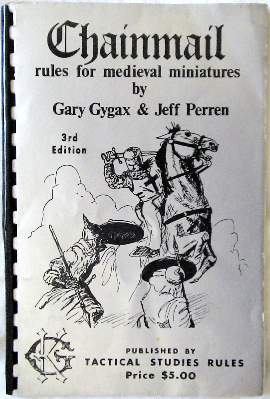
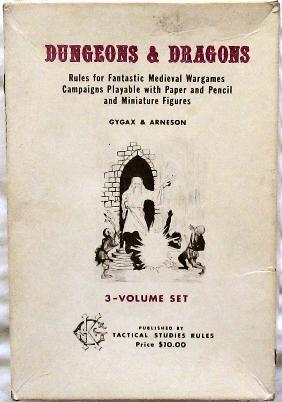
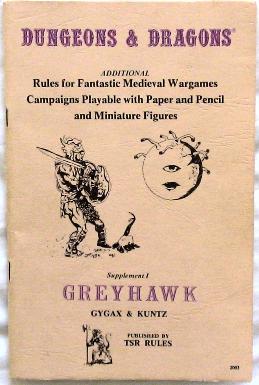
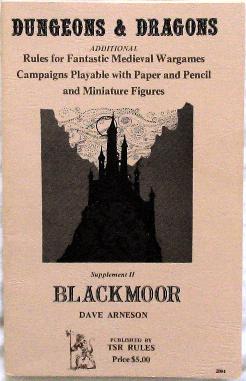
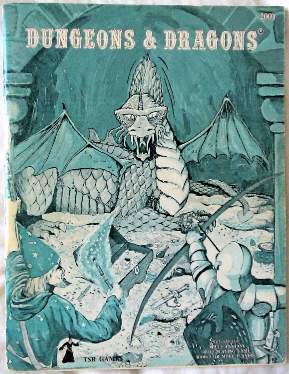
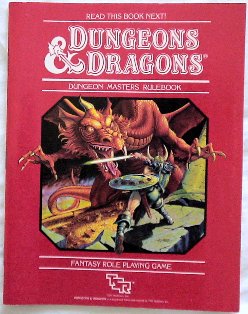
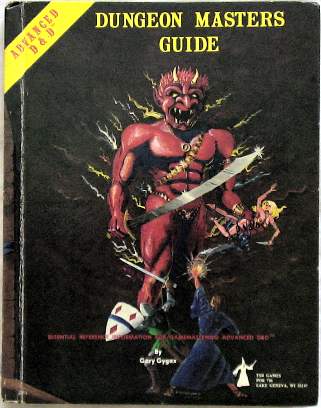
This is part one of a four-part series on the evolution of character experience in role-playing games. The next installment will cover other early games, such as Chivalry & Sorcery, Tunnels & Trolls, Traveller, Gamma World, Runequest, Dragonquest, and Champions.